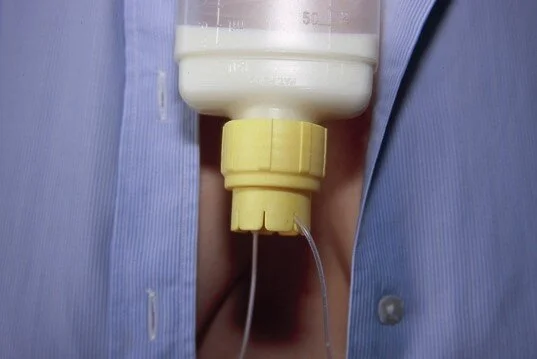Latching & flow regulation
When mother and baby start with their first breastfeeds with an at-breast supplementer, they often have already been through some frustrating experiences. So mom and baby are faced with trying to engage in the task of finding out how at-breast supplementation functions, in as relaxed a state as possible and, perhaps, with some curiosity and also with some patience. As it is a new step for you as mother and also a new step for your baby, it is helpful if to choose an opportune moment and allow yourself some time, so that both of you can become relaxed.
Now, you can put your baby to the breast with the at-breast supplementer.
In an appropriate moment, put your baby to breast as usual. Either already open both tubes in advance – or open them as soon as your baby begins to suck at the breast. Very important for the first breastfeeding with the SNS: Both tubes must be open so that the milk flows easily.
In the following two videos you see to variations of how to latch a baby with a tube - first with the tube at the UPPER LIP - this works well, if your baby opens his / her mouth widely during latching. This is mostly the case for very young babys:
And here you see how to latch with tube at the LOWER LIP - this works also, if your baby does not open his / her mouth widely during latching. This is mostly the case for babys older than three-four weeks:
Whatever way of taping the tube and latching your baby with the at-breast supplementer works for you is fine - if necessary you can try both ways.
Is milk flowing through the tube?
You feel that the start with the at-breast supplementer has gone well:
if your baby begins to suck and continues to suck
if the sucking is comfortable for you
if milk becomes less in the container
in the SNS - if, after about a minute, air bubbles rise in the container
In the following video you see, when it is time to open the first and the second tube of the SNS and what happens in the tubes:
If the milk does not flow look for possible causes at Important details & further information.
How do you regulate the flow rate?
In the SNS, the greatest influence on the flow rate is, whether the second tube is open or closed. If both tubes are open, because they are not clamped in the groves, the milk flows more quickly because air enters through the second tube. The milk flows considerably more slowly if one tube is open and the second is closed off. In other devices, the flow rate can only be increased by hanging the container higher or using warmer milk.
In the SNS, the milk flows more quickly:
If both tubes are open, because they are not clamped in the groves, the flow is faster, because air enters through the second tube.
if both tubes are open
if you hang the container higher
if you select a tube with a faster flow (the tubes with the transparent ring have the fastest flow, tubes with the white ring have medium flow, the tubes with a rust-colored ring have the slowest flow)
(if you use warmer milk – only if you need a very fast flow – in general use milk at room temperature)
The milk flows more slowly,
The milk flows considerably more slowly if one tube is open and the second is closed off.
if one tube is open, the other is closed
if the container hangs lower
if you select a tube with a slower flow
At the beginning, a rapid flowrate makes sense. Later on you adapt the flowrate in accordance with your own assessment. It is only with premature infants that you begin with a slower rate of flow!
What can you expect at the beginning?
Realistic expectations are important. You and your baby need time to get used to breastfeeding with a nursing supplementer and your confidence grows.
If your baby takes the breast with the tube in his mouth, that’s a good beginning.
If your baby has drunk 5 ml from the at-breast supplementer, then the tube was on the right place in his mouth and your baby has gotten milk from the device through negative pressure.
All that is more than this during the first breastfeed(s) with the at-breast supplementer is excellent.
If, up until now, your baby has fed from a bottle, it makes sense to place the bottle with half of the required amount on the table and then try out putting him to breast with the supplementer. If the baby does not manage with the at-breast supplementer immediately, you can give him a bit from the bottle and then try again with the device.
Mostly it takes some time until the baby can drink a considerable amount via the at-breast supplementer. At the beginning, many mothers breastfeed once or twice a day with the device and scale up, from day to day, until all of the bottle feeds have been replaced by at-breast supplementation. You need time for the transition…”Slower is faster!”
More about breastfeeding with an at-breast supplementer in the booklet on the SNS.
The next steps
After the first breastfeed you need to know: How to clean an at-breast supplementer
Helpful for at-breast supplementation are some Important details & further information
Back to the Overview At-breast supplementation
© 2020 Márta Guóth-Gumberger. All rights reserved.


